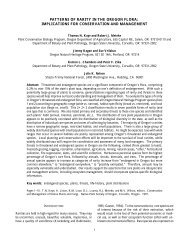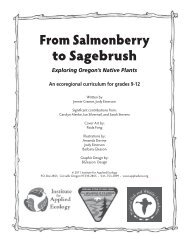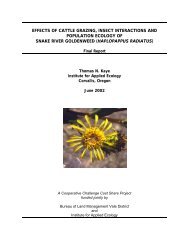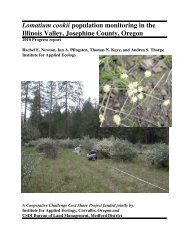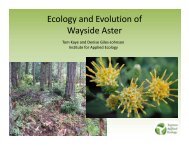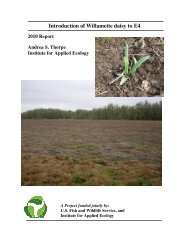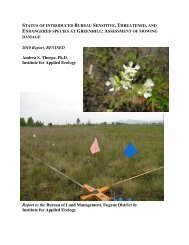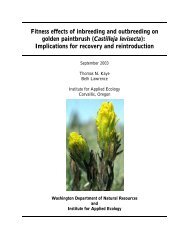Determining appropriate management techniques for Willamette ...
Determining appropriate management techniques for Willamette ...
Determining appropriate management techniques for Willamette ...
Create successful ePaper yourself
Turn your PDF publications into a flip-book with our unique Google optimized e-Paper software.
ERDE Management Progress Report, 2012<br />
Demography and Management of <strong>Willamette</strong> Daisy (Erigeron decumbens)<br />
conducted as a MS thesis by Katie Gallagher, at Oregon State University and will be included in the<br />
final report.<br />
METHODS<br />
Plugs <strong>for</strong> outplanting in 2011 were produced in fall 2010 – spring 2011 using seed from two Recovery<br />
Zones, Corvallis West (Allen and Allen/Muddy Creek), and Eugene West (Balboa and Oxbow West<br />
populations). In September of 2010, seeds were placed in germination trays and then placed into 16<br />
weeks of cold stratification at 6°C. Seeds were checked weekly and misted with distilled water to keep<br />
them moist. If any mold was present, damaged seeds were removed and a solution of distilled water and<br />
hydrogen peroxide was sprayed on the seeds. The seeds were removed from cold stratification and<br />
placed in a room with a 25 o C day / 15 o C night temperature cycle and 8 h day / 16 h night lighting<br />
cycle one week prior to planting into conetainers. Plants were planted into conetainers 3.81cm wide and<br />
13.97cm deep in trays of 98 and kept at the OSU West Greenhouse. Pots were filled with Gardner’s<br />
Gold potting soil and placed in a greenhouse maintained at 21 o C during the day and 13 o C at night with<br />
14 hour daily artificial light provided by Sun System 3 - 400 HPS bulbs. Pots were watered from the<br />
bottom 1-4 times per week as necessary. An 8-8-8 fertilizer was sprayed weekly on the plants and then<br />
rinsed off to prevent burnt leaves. At approximately eight weeks, the plants were inoculated with<br />
nematodes to prevent fungus gnats from attacking the young plants. One week prior to outplanting, all<br />
pots were placed outside to harden-off. The same procedure was followed in 2012-2013 <strong>for</strong> the plants<br />
to be outplanted in the spring of 2013.<br />
Outplanting<br />
In April 2011, 900 plants were outplanted at Finley National Wildlife Refuge (Finley); 450 each in Field<br />
29 and Field 8 North (Appendix A). Finley is located approximately 16 km south of Corvallis, Oregon, in<br />
the Benton West Recovery Zone (USFWS 2010). Historical records indicated that this Refuge once hosted<br />
a <strong>Willamette</strong> daisy population, but the population has not been observed since the 1990’s. In 2007 and<br />
2008, <strong>Willamette</strong> daisy was introduced to four sites at Finley, including 174 at Field 29. Plots <strong>for</strong> this<br />
experiment were located approximately 30m from the 2007 and 2008 introductions. Field 29 and Field<br />
8 North were selected because of their relatively low cover of exotic plants, general habitat suitability<br />
<strong>for</strong> <strong>Willamette</strong> daisy, and ease of access <strong>for</strong> <strong>management</strong>. Both sites have been under active restoration<br />
and <strong>management</strong> (including herbicide treatments, mowing, and seeding) by USFWS.<br />
At each site, three 14m x 22m blocks were marked with rebar pounded flush with the ground and<br />
topped with an orange cap. The three blocks are adjacent, and the NW corner of the macroplot was<br />
marked with a T-post. Within each block there were six 6m x 6m treatment plots, marked with 8” nails<br />
pushed flush with the soil surface and capped with marking whiskers. There is a two meter buffer<br />
between each treatment square. <strong>Willamette</strong> daisy plugs were planted along a 5m x 5m grid in the<br />
center of each treatment plot (25 plants per plot) (Appendix A, Appendix B).<br />
At Fern Ridge Natural Area, 716 plants were outplanted, 360 at Applegate, and 356 at Kirk NE, in<br />
April 2011 (Appendix B). Fern Ridge Natural Area is located approximately 60km south of Corvallis,<br />
Oregon in the Eugene West Recovery Zone (USFWS 2010), and is managed by the Army Corps of<br />
Engineers (ACOE). Applegate and Kirk East were selected because of habitat suitability <strong>for</strong> <strong>Willamette</strong><br />
3



